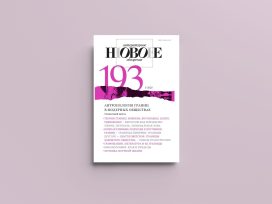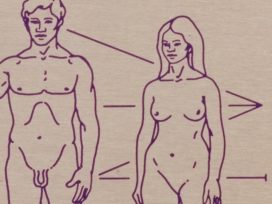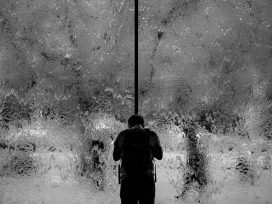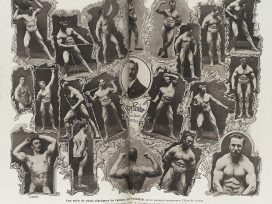In March of 1959, just after the triumph of the Cuban Revolution, Fidel Castro founded the Instituto Cubano del Arte e Industria Cinematográficos (ICAIC) to promote revolutionary ideals for Cuban audiences. Themes dealing with a whole range of social issues emerged, the ideology behind the images serving to shape a society with socialist values. Paradoxically, the portrayal of the sexes in many post-revolutionary films was at odds with the Revolution’s attempt to revise the female (and hence, the male) role in Cuban society.
The end of the 1980s and the early 1990s represent a turning point in Cuban cinema and a departing point for a “revolutionary” approach to gender representation. As Isabel Arredondo notes: “At the end of the 1980s, female representation in Cuban film shifted from history to stories, from the communal to the individual, from type characters representing a group of people to individuals.”
A new psychosexual formation of gendered identities motivated a search for new gender representation in film, portraying social tensions and shifting emphasis towards the active participation of women in the creation of narrative image. Challenging the strong legacy of sexism, Cuban film now vindicated the insertion of the personal story into history, the agency of female characters and the creation of new spaces and roles for men and women, so elucidating the relation of human consciousness to historical and social process and change. I will argue that the manner in which these films construct the female and male characters constitutes a specific series of feminist narrative strategies whose function is to subvert, resist and re-define the cultural tradition from which the films evolved.
This study will focus on two specific short films from the collective Mujer transparente (Transparent Women) (1990), a five-part feature film made by both female and male filmmakers and under the general direction of Humberto Solás. I have selected this film to show that after thirty years of revolutionary cinema, complex gender issues are still pending. It may be helpful if I first define to what extent Mujer transparente can be considered a revolutionary feminist film. When using the term “feminism”, it is important to bear in mind the different meanings that it can take on in different contexts. Luce Irigaray’s definition corresponds most closely to the “feminism” expressed in the different episodes of Mujer transparente. She redefines the term as “an attempt to create a process where women (and the feminine) can be speakers, agents as women”.
Mujer transparente develops a critique of the structure of patriarchal thought and posits a strategic restructuring through episodes that propose a feminist politics which work on two fronts at once – that of “global” politics, addressing the problem of women’s universal oppression, and that of “local” politics, addressing the specificity and complexity of each woman’s particular situation.
The protagonists of the five short films are of different ages and from different social classes, so creating a social panorama of the lives of contemporary Cuban women. Adriana was directed by Mayra Segura, Isabel by Héctor Veitía, Julia by Mayra Vilasís, Zoë by Mario Crespo and Laura by Ana Rodríguez. There is an individual story in each of the five shorts, although there is a sense of coherence running throughout. While the film title Mujer transparente has connotations of invisible women, silenced, not seen, not heard, without an identity, conversely it could be perceived as portraying women who are visible, now making their ideas heard and who are clear and transparent to the viewers. “Mujer” (“woman”) in the singular may refer to the main female protagonist of each story, or apply generically to “woman”, affording the story a universal dimension. “Transparente” translates as “transparent”: the protagonists can “be seen through”; they feel “invisible”, either to a member of their family, a friend, colleague or to society in general. The transparency of these women also reveals that in the male gaze they are devoid of any individual traits. At the same time, Mujer transparente offers a particular area of “visible” feminine discourse – that of feminine introspection.
I have chosen to concentrate this discussion on Isabel and Zoë, both directed by men. These are among a substantial number of films made by male directors whose use of strategies that destabilise and subvert existing traditions shows that perpetuation of the role model imposed on women by patriarchal societies is not inevitable.
In Isabel, directed by Héctor Veitía and co-scripted by Tina León, a middle-aged woman is shown trying to adapt to her role in the new Cuba; this provokes reflection on her past and realisation of her social restriction as a woman. Her narrative voice-over runs parallel to the diegesis of the film. It is a powerful cinematic device that the director uses to bring out hidden feminine identity and address the silent status of women. This approach is far removed from classical cinema, where viewers had, and arguably still have, no access to the female voice; as film theorist Ann Kaplan argues, “women as women are absent from the screen and from the audience”, a phenomenon attributable to what Laura Mulvey calls the “male gaze”. According to Mulvey, there are three “gazes” in film – that of the camera, the audience, and the actor – all of which are essentially male and function in line with male desire.
Apart from Zoë, all of the films in Mujer transparente use narrative voiceover to suggest that women are silenced in society and have no voice of their own, and also to make the spectator re-evaluate the relationship between the characters. The voice-over, which acts as Isabel’s inner conscience, expressing her thoughts and desires, continually questions and comments. This resonates with Elaine Showalter’s comments on the three stages in the work of a woman writer:
There is a prolonged phase of imitation of the prevailing modes of the dominant tradition, and internalization of its standards of art and its views on social roles. Second, there is a phase of protest against these standards and values, and advocacy of minority rights and values, including a demand for autonomy. Finally, there is a phase of selfdiscovery, a turning inward, freed from some of the dependency of opposition, a search for identity.
These stages echo the steps taken in the process of introspection: acknowledging one’s hopes and inner thoughts; questioning constructed norms and commenting on them; and then finally, self-discovery and self expression.
Via the voice-over, we hear how Isabel views herself as a “ghost”, “a melodramatic mother” and as “a goldfish that awakens in need of oxygen”. Her words reveal her interior state of fragmentation and worthlessness. (Here “ghost”, an invisible entity, constitutes another reference to the invisibility and transparency suggested by Mujer transparente.) In her cultural imprisonment as a “goldfish”, Isabel adds that it is not oxygen that she needs, but to be acknowledged as an individual in her own right, to be visible and valued by those around her. She does not believe that the compliments given by her employers are really directed at her. Her self-esteem is so low, she thinks that they are referring to “someone other than herself “. Nancy Chodorow argues that psychoanalysis goes some way towards explaining this mindset, with respect to the system that women are born into: “We need to explain and understand the tenacity of people’s commitment to our social organisation of gender and sex… Psychoanalysis helps here, because it shows us that we also live our past in the present.”
Isabel’s acknowledgement and respect in the professional environment conflicts with her undervalued role of mother and wife in the domestic sphere. Although recently promoted to a managerial position, she fails to tell Luis, her husband, knowing the opposition he and her two grown up children will present. While Luis constantly complains about how demanding his job is, Isabel does not say a word about her day, despite it being just as stressful. It is almost as if she feels she has no right to voice her discontent to her husband. Simone de Beauvoir argues in The Second Sex that man represents the subject and woman is the Other in patriarchal society: “To be the Other is to be the non-subject, the non-person, the non-agent – in short, the mere body”.
In an attempt to find a balanced identity, Isabel attempts to empower herself by neutralising her appearance: she gets her hair cut short and starts to wear a business suit and glasses in the professional context. This metamorphosis amounts to a masculinised version of herself. It is interesting to note that Isabel does not wear her glasses when she is at home. On the subject of Hollywood cinema, Mary Ann Doane has observed, “the woman with the glasses signifies simultaneously intellectuality and undesirability; but the moment she removes the glasses… she is transformed into spectacle, the very picture of desire… the intellectual woman looks and analyses, and in usurping the gaze, she poses a threat to an entire system of representation.”
Isabel’s internalised cultural role as an unproblematic mother, devoted housewife and submissive sexual partner leads her to control the threat that her newly evolved identity represents to her husband and family. There are voice-over references to “feminine” media, the soap opera and melodrama. While ironing, Isabel watches a soap opera and on the bus she thinks: “I am tragic, that is why they do not take me seriously, and everything is a melodrama.” The genre of melodrama has been traditionally addressed to women, not only as a vehicle to expose the restrictions and limitations that patriarchal myths impose, but also as a tool to coerce women to accept such restrictions and limitations as being natural and inevitable.
Isabel’s internal metamorphosis begins with a flashback to a trip to the beach with her husband and his friends. In scenes which contrast her oppressive domestic situation with the psychological changes she is undergoing, Isabel is shown serving coffee to her husband and his friends. In her study of Cuban cinema, Catherine Benamou asserts that the “habitual performance” of serving coffee to one’s husband/master not only calls attention to the structuring of gender relations in the national culture, but also serves as a “gauge against which the emancipation of the protagonists can be measured”. After Isabel serves the coffee, her husband and his friends discuss work-related problems. She expresses an opinion, but is immediately “put in her place” by her husband, who curtly retorts that she does not know what she is talking about. Her opinion, in her husband’s gaze, carries no value at all. Later, when she asks him why he does not “notice” her, he silences her by asking her for a cup of coffee. At this point, Isabel tells him to get it himself – her first refusal to conform to her “invisible” and “silenced” role any longer.
In the next scene, however, we see Isabel walking into the sea. The camera follows her, giving us a whole, unfragmented view of her; in other words, there are no conventional close-ups. This technique provides an objective view, undistorted by the male gaze. In Jungian terms, walking into the sea can be seen as Isabel’s return to her origins – to her authentic self. Isabel is reborn, psychoanalytically speaking, in her attitudes towards her world and her female psyche – undefined by patriarchal structures. The metaphor of water-as-female-genealogy is most exposed in this key moment of her journey of self-discovery; she comments via the voice-over, “If only my children could hear me, I am not melodramatic.” In Freudian terms, children are seen by the mother as an extension of her own ego, and a mother-child bond can represent a threat to the father – it could overrule the law of the father. Isabel’s yearning for her children’s understanding effectively challenges her husband’s dominance and control. Isabel enters the sea wearing flowing white clothes, symbolising freedom and regeneration, a sense of liberation. This is the climax and turning point of the film. In creating her own identity, Isabel has found a new representation for her gender. Following her metaphorical “rebirth”, she is more vibrant and alive; this is reflected cinematographically in livelier jump cuts, with more movement and a faster pace: She is seen talking and laughing with female friends. There is a feeling of female solidarity, a sense of a more enlightened future for women in the new Cuba. This is the first time we see Isabel smile, her inner contentment revealing itself.
The film ends with a distant camera shot of Isabel alone in a park. Through the voice-over she reveals that she now knows why people run away – because they cannot take it anymore. Her final words are defiant, affirming that her family underestimates her. She says that they do not know what she is capable of: in the new Cuban cinema, revolutionary thoughts are manifesting themselves in the psyches of the oppressed. Isabel may not have successfully redefined her role as a female, however, she has a new insight into her life. She is shown to have experienced an awakening through the changes that the Revolution has brought to her country.
Not all the films in Mujer transparente emphasise female agency to the same degree. In Zoë, Mario Crespo depicts a young girl who goes against all the traditional social norms. She is a promiscuous, rebellious and independent student, who does not attend her classes in college and lives alone and isolated in a garage. Unlike Isabel, Zoë does not have an introspective voice. The film has a narrative structure, with no voice-over. We have access to Zoë’s thoughts just once, via a tape recording played by a classmate, “El Acorazado” (“Battleship”). It could be argued that Zoë is an object not subject of the (male) gaze. Furthermore, the episode is framed within a male gaze. It starts when a classmate El Acorazado first visits Zoë in her garage and ends when he leaves it at the end of his visit.
Zoë’s body is eroticised and fragmented. Her opening portrayal is highly sexualised. Her arms are over her head in an open, seductive pose; she has very short hair and is wearing a man’s loose-fitting but flesh-revealing top. In contrast, her male classmate is dressed in a tight-fitting T-shirt with rigid, vertical lines, which might be a reference to the inflexible normative patriarchal values he embodies. Zoë has distinct undertones of the femme fatale, in that she attempts to use her sexuality to manipulate and control.
As the narrative evolves, Zoë appropriates a masculine position by turning her classmate into a sexual object. She tells him to take off his trousers after he sits on a paint-stained chair, then draws him naked and seduces him. While she is drawing him, Zoë laughs at his nakedness, and makes demeaning comments about him, expressing her sense of control over him. He asks questions but she ignores them – a reversal of the traditional masculine and feminine roles. In Freudian terms, Anne Kaplan identifies asking questions as perhaps “the only discourse available to women as a resistance to patriarchal domination”. Zoë entitles her drawing “Looking for Men” and not “Looking for a Boyfriend” as El Acorazado suggests. In another scene, he asks her how many men she has slept with, and she answers “hundreds, thousands”, using a masculine form of discourse or “locker-room talk” to affirm the appropriation of her masculinised role. Her masculinisation is further emphasised when she makes him the recipient of undervaluing and undermining phrases such as: “I do not think about you… I did not vote for you”. According to Doane, “it is understandable that women would want to be men, for everyone wants to be elsewhere than in the feminine position”.
Unlike Isabel, in Zoë, there are sex scenes. They are voyeuristic, a mechanism that the dominant cinema uses to construct the male spectator in accordance with the needs of his unconscious; through voyeurism, Zoë is eroticised, the threat that she poses as a woman (possessing a sinister organ) neutralised. Mulvey explains:
In a world ordered by sexual imbalance, pleasure in looking has been split between active/male and passive/female. The determining male gaze projects its fantasy onto the female figure, which is stylized accordingly. In their traditional exhibitionist role, women are simultaneously looked at and displayed, with their appearance coded for strong visual and erotic impact so that they can be said to connote to-be-looked-at-ness.
As the episode concludes, Zoë is turned into an object of the camera’s male gaze. She lies naked while El Acorazado jumps out of bed to get dressed to go back to college. This scene, set in Zoë’s garage, makes her the spectacle in El Acorazado’s and the camera’s male gaze. As he leaves, El Acorazado breaks the deal to pass on excuses for her absence at college. Zoë is left alone and isolated in her garage/world – a marginal location that can only further emphasise her social entrapment. Now the male character is in control. The episode closes with an eloquent male dominance.
There are echoes of the opening scene in the camera angle and framing used when El Acorazado initially enters Zoë’s garage. As he departs, he leaves the door open, letting the daylight in, overexposing the frame and allowing Zoë’s world to be “penetrated” by the outside world.
The spectator is forced to rely on the male to forward the narrative. Male agency is in control, as has been the case in classical cinema – “the male protagonist is free to command the stage, a stage of spatial illusion in which he articulates the look and creates the action”, Mulvey observes. Zoë’s transgressions are seen to lead to her downfall. She fails college and is left secluded, misunderstood and marginalised.
Mulvey identifies the concerns of film noir with male castration anxiety. “Investigating” and “demystifying” the woman is “counterbalanced by the devaluation, punishment or saving of the guilty object”. Cuba, with its rigidly defined gender roles, has constructed in Zoë a powerful, independent woman, only to condemn her in the end.
Overall, Zoë shows that simply reversing gender roles is not progressive in feminist terms. It is destructive in that it perpetuates the roles designed in patriarchal society. Zoë and Isabel differ according to their directors’ perspectives. Nevertheless, both female characters are striving for selfrealisation, questioning their submissive roles, trying to etch out a new identity for themselves as women in post-revolutionary Cuba.
Both films reveal the complexity of reversing centuries-old legacies of sexual discrimination. By recording the experiences of female heroines and exposing their dissatisfaction and pain, as well as exploring the repressed expression of the feminine from the male perspective, they make a profound impact on a tradition that can no longer maintain fossilised and unrealistic representations of woman and man. Thus the narratives conceive fictional worlds in which patriarchal images and conventions are significantly revised.
These two films demonstrate that Cuban cinema in 1990 is discovering a truly revolutionary feminist discourse within the male gaze. Eloquently, this collective effort explores, as Mulvey has noted, how “cinematic codes create a gaze, a world, and an object, thereby producing an illusion cut to the measure of desire”, and also how “these cinematic codes and their relationship to formative external structures” must be deconstructed and broken down before they can be challenged. All in all, Mujer transparente is part of an important project that painstakingly creates a place for a new generation of revolutionary filmmakers of both genders at the foreground of contemporary feminist thought in Cuban cinema.
Works Consulted
Francine A’Ness, “A Lesson in Synthesis: Nation-Building and Images of a New Cuba in Fresa y Chocolate.” Lucero: A Journal of Iberian & Latin American Studies, 7, 1996.
Isabel Arredondo, “From Transparent to Translucid: Cuban filmmakers in 1990”, Latin American Literary Review, 49, 1997.
Catherine Benamou, “Cuban Cinema. On the Threshold of Gender”, in Diana Robin and Ira Jaffe (eds), Redirecting the Gaze: Gender, Theory and Cinema in the Third World. State University of New York Press, 1990.
Julianne Burton (ed.) Cinema and Social Change: Conversations with Filmmakers. Interview with Humberto Solás. University of Texas Press, 1986.
Nancy Chodorow, Feminism and Psychoanalytic Theory. Yale University Press, 1989.
Elizabeth Cowie, “Women, Representation and the Image”, Screen Education, 3, 1977.
Mary Anne Doane, “Film and the Masquerade: Theorising the Female Spectator” in Sue Thornham (ed.), Feminist Film Theory: A Reader. EUP, 1999.
Mary Eagleton (ed.) Feminist Literary Reader. Basil Blackwell, 1986.
Francisco Cota Fagundes, “The Search for the Self: Alvaro de Campos’s ‘Ode Marítima'”, in George Monteiro (ed.) The Man Who Never Was: Essays on Fernando Pessoa. Gave Brown, 1981.
Luce Irigaray and Margaret Whitford, Philosophy in the Feminine. Routledge, 1991.
Ann Kaplan, Las mujeres y el cine. A ambos lados de la cámara. Ediciones Cátedra, 1998. – “Is the Gaze Male?”, Feminism and Film. OUP, 2000.
Laura Mulvey, “Visual Pleasure and Narrative Cinema”, in C. Penley (ed.), Feminism and Film Theory. BFI, 1988.
Brígida M. Pastor, Fashioning Cuban Feminism and Beyond. Peter Lang, 2003.
Sue Thornman (ed.) Feminist Film Theory: A Reader. EUP, 1999. – Passionate Detachments. An Introduction to Feminist Theory. EUP, 2000.
Brígida Pastor wishes to acknowledge her gratitude to the British Academy and the Humanities Research Council for their support of her research project on Cuban film, and to Philip Illsley for his stimulating and incisive thoughts on film.






